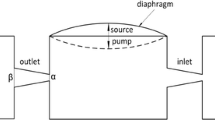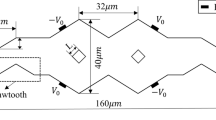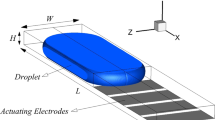Abstract
This study characterizes and analyzes the performances of micro diffusers/nozzles with five types of enhancement structures and one of conventional micro nozzle/diffuser valve. The pressure drops across the designed micro nozzles/diffusers are found to be increased considerably when the obstacle and fin structure are added. Further, the micro nozzle/diffuser having added circular area reveals the lowest pressure drop, owing to the hydraulic diameter is increased by circular area and lower interface friction. The maximum improvement of the loss coefficient ratio is about 16% for an added 3-fin structure operated at a Reynolds number around 70. Upon this situation, the static rectification efficiency improves 4.43 times than the conventional nozzle/diffuser. Experimental results indicate the performance peaks at a Reynolds number around 70, and an appreciable decline is encountered when the Reynolds number is reduced. It is due to the efficiency ratio of conventional micro nozzle/diffuser significant increases with the Reynolds number.








Similar content being viewed by others
Abbreviations
- A :
-
Cross-sectional area (m2)
- C :
-
Perimeter (m)
- D h :
-
Hydraulic diameter (m)
- f :
-
Friction factor
- H :
-
Depth (m)
- L :
-
Length (m)
- \( \dot{m} \) :
-
Mass flowrate (kg/s)
- Re :
-
Re number
- \( \overline{u} \) :
-
Mean velocity (m/s)
- V :
-
Velocity (m/s)
- W :
-
Throat width (m)
- x :
-
Position from the neck (m)
- θ :
-
Opening angle (°)
- α :
-
Aspect ratio
- μ :
-
Dynamic viscosity (Ns/m2)
- η :
-
Ratio of the loss coefficient of nozzle and diffuser
- ε :
-
Static rectification efficiency
- ξ:
-
Total pressure loss coefficient
- ρ:
-
Density (kg/m3)
- ΔP :
-
Pressure drop (Pa)
- 1:
-
Region 1
- 2:
-
Region 2
- 3:
-
Region 3
- x :
-
Position of neck
- d, diff:
-
Diffuser
- n, nozzle:
-
Nozzle
- +:
-
Positive
- −:
-
Negative
References
Chen YT, Kang SW, Wu LC, Lee SH (2008) Fabrication and investigation of PDMS micro-diffuser/nozzle. J Mater Process Technol 198:478–484
Gerlach T (1998) Microdiffusers as dynamic passive valves for micropump applications. Sens Actuators A 69:181–191
Gerlach T, Wurmus H (1995) Working principle and performance of the dynamic micropump. Sens Actuators A 50:135–140
Hartnett JP, Kostic M (1989) Heat transfer to Newtonian and non-Newtonian fluids in rectangular ducts. Adv Heat Transf 19:347–356
Idelchick IE (1993) Handbook of hydraulic resistance, 3rd edn. Begell House, New York
Jiang XN, Zhou ZY, Li Y, Yang Y, Huang XY, Lin CY (1998) Micronozzle/diffuser flow and its application in micro valveless pumps. Sens Actuators A 70:81–87
Stemme E, Stemme G (1993) A valveless diffuser/nozzle-based fluid pumps. Sens Actuators A 39:159–167
Tiren J, Tenerz L, Hok B (1989) A batch-fabricated non-reverse valve with cantilever beam manufactured by micromachining of silicon. Sens Actuator 18:389–396
Ullmann A, Fono I (2002) The piezoelectric valve-less pump—improved dynamic model. J Microelectromech Syst 11:655–664
Van De Pol FCM (1989) A pump based on micro-engineering techniques. Dissertation, University of Twente, The Netherlands
White FM (1986) Fluid mechanics. McGraw-Hill, New York, pp 334–336
Yang KS, Chen IY, Shew BY, Wang CC (2004) Investigation of the flow characteristics within micro diffuser/nozzle. J Micromech Microeng 14:26–31
Yang KS, Chen IY, Wang CC (2006) Performance of nozzle/diffuser micro-pump subject to parallel and series combinations. Chem Eng Technol 29:703–710
Yang KS, Chiang CM, Lin YT, Chien KH, Wang CC (2007) On the heat transfer characteristics of heat sinks: with and without augmentation. Int J Heat Mass Transf 50:2667–2674
Yang KS, Chen IY, Chien KH, Wang CC (2008) A numerical study of the nozzle/diffuser micro-pump. Proc Inst Mech Eng Part C J Eng Mech Eng Sci 202:525–533
Zdeblick MJ, Angell JB (1987) A microminiature electric-to-fluidic valve. Tech Dig Transducers 87:827–829
Acknowledgments
The authors are indebted to the financial support from the Bureau of Energy and Department of Industrial Technology, the Ministry of Economic Affairs, Taiwan and National Science Council of Taiwan under the contract no. of NSC 98-2218-E-151-001.
Author information
Authors and Affiliations
Corresponding author
Rights and permissions
About this article
Cite this article
Yang, KS., Chen, IY., Wang, CC. et al. Novel no-moving-part valves for microfluidic devices. Microsyst Technol 16, 1691–1697 (2010). https://doi.org/10.1007/s00542-010-1069-x
Received:
Accepted:
Published:
Issue Date:
DOI: https://doi.org/10.1007/s00542-010-1069-x




